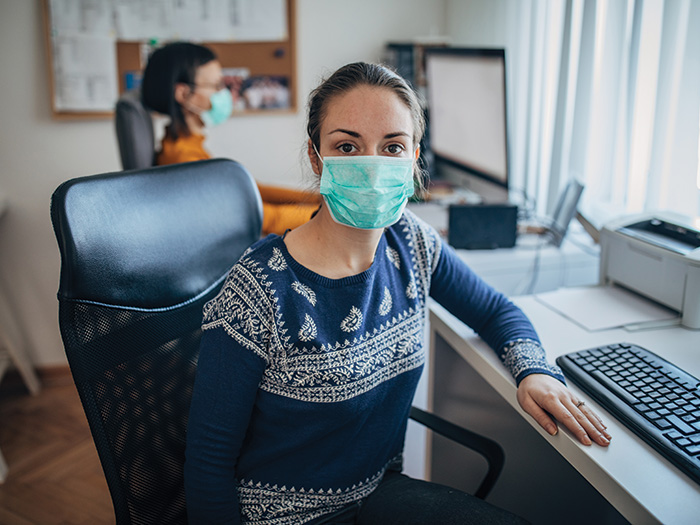COVID-19’s Unprecedented Impact on the Workforce: How Employers Can Help Employees Adapt

COVID-19 ushered in an unprecedented era of workforce management.
In the span of a few weeks, companies emptied offices, scrambled to introduce remote work plans, and devised ways to keep employees engaged and productive as they worked full days in pajamas.
Meanwhile, companies had to adhere to new paid sick leave regulations, secure data, keep worker safety top-of-mind and not run afoul of wage-and-hour regulations.
If the workforce management tasks weren’t Herculean enough, they came as business leaders were forced to handle dwindling revenue, shuttered storefronts, cancelled events and a customer base forced to shelter-in-place indefinitely.
Think it’ll all be over soon? Think again.
“I don’t think we’re going back to a pre-COVID situation in our lives unless there is a substantial amount of herd immunity or a vaccine,” said Dr. Jeff Levin-Scherz, a professor at the Harvard University School of Public Health and national co-leader of the health management practice at Willis Towers Watson.
“For us to return to life as we knew it three months ago will require a vaccine.”
A vaccine could take upwards of a year or longer to develop and distribute to the public — so this “new normal” could last a while.
That presents an opportunity for businesses. Whether they frantically threw a workforce management plan together or meticulously worked out every detail, they can take steps now to make those plans as effective as possible.
If successful, they’ll keep employees engaged, safe and informed through the pandemic — and be poised for success on the other side.
Focus on the Employee
The pandemic and ensuing shutdown forced nearly every company to examine line items and cut expenses. But view employees as a cost center at your own peril.
Talent and innovation are key to managing through tough times.

Dr. Jeff Levin-Scherz, national co-leader, health management practice, Willis Towers Watson
“Employees will remember how they were treated in times of tragedy, so make sure to take care of your employees now,” said Les Williams, co-founder and chief revenue officer at Risk Cooperative.
“Those efforts go a long way and bring good will. People will work harder if they think they are valued.”
If you do conduct layoffs or furloughs, keep in close contact with those workers in the hopes of rehiring them when the crisis ends, experts said.
Start with clear communication about the progression of the virus and the company’s response.
Your people are likely inundated with information from Twitter and Facebook, so make sure to share updates from pros like the Centers for Disease Control and Prevention.
Remember that it’s a trying time for mental health, too, so encourage workers to utilize Employee Assistance Programs (EAPs) that offer mental health counseling and other services.
One company doing a good job of preparing for the “new normal” is Interos, a supply chain risk management company with offices in Menlo Park, Calif. and Arlington, Va.
As the virus spread, executives formed a COVID-19 task force that sent twice-a-day emails detailing the spread of the virus and all company actions — like upgrading paid sick leave policies and deep cleaning workspaces.
Company leaders also worked to keep morale high — holding happy hours, quiz games and new hire lunches on video chat. They offered $50 per month for home office equipment like a second monitor or extra internet bandwidth.
With anxiety running high across the country, they made sure to remind employees about mental health offerings and increased one-on-one check-ins.
“If you don’t have a lot of outside conversations, your mental stress and anxiety could reach levels that are not helpful,” said Miriam Wardak, senior vice president of human resources at Interos.
“In person, it’s easy to see if someone is having trouble and lend a helping hand. That’s much harder to do virtually. That’s why check-ins have become critical to making sure our team members are doing okay.”
Interos is one of the lucky ones. Business is steady and they didn’t conduct layoffs. But Wardak knows they still need to be diligent.
“Taking care of our community is our #1 priority,” she said.
“We’ll get through this together.”
Develop a Telecommuting Playbook
The mass migration to working from home means video chats are going to be a much bigger part of our daily lives. And they’ve performed well so far.
“Since we started using video conferencing, we actually have better conversations, because we can read people’s faces better, we’re not stepping over one another, and it makes us more productive,” said Williams.
“We were amazed when we transitioned to video chat how much better it’s been to communicate ideas, particularly complex ideas.”
But video chats come with security risks: “Zoombombing” — where uninvited guests crash a meeting on the popular video chat platform — have become en vogue.
Chipotle was forced to end a public Zoom chat after a user began broadcasting pornography to the hundreds in attendance. To combat that, keep attendees in a virtual “waiting room,” then admit them one by one.
You also need to make sure accommodations are still made for people with special needs. If an employee is deaf, for example, they shouldn’t be excluded from participating in virtual meetings.
Also, there are other steps you need to take to protect data security:
- Offer a VPN service for secure web connections.
- Beware of unencrypted home WiFi networks.
- Make sure to set up two-factor authentication for login security.
- Forbid usage of personal email accounts for work.
- And don’t print out sensitive documents at home.
Stay Ahead of Sick Leave and Legal Requirements
Companies with 500 or fewer workers must adhere to the Families First Coronavirus Response Act (FFCRA), requiring up to two weeks of paid sick leave for employees that contract COVID-19 or need to act as caretakers.

Les Williams, co-founder and CRO, Risk Cooperative
Some parents are eligible for up to 12 weeks of expanded family and medical leave if an employee is unable to work, because they’re caring for a child whose school is closed due to COVID-19.
There are exceptions, and the leave will be reimbursed with federal tax credits.
Larger companies are voluntarily stepping up paid sick leave — especially those with employees on the front lines, like grocery stores or delivery services.
PepsiCo is matching the offering required by the FFCRA of two weeks paid leave for employees that contract COVID-19.
Meanwhile, Target is offering employees over 65, who are pregnant or have underlying health conditions, one month paid leave to stay home during the crisis.
COVID-19 also brings unique legal risks.
Examine your paid time off policy carefully. If you require a doctor’s note for an absence, give people a bit more time to get that documentation together, said Nichole D. Atallah, attorney at Piliero Mazza.
“If you have a policy that’s so restrictive that you effectively deny people leave and is not otherwise required by law, then you’re going to have problems with the Department of Labor,” said Atallah.
Amend work-from-home policies to represent the current emergency situation. Don’t require a dedicated eight-hour workday.
Employees might have children to care for and need to work around those responsibilities.
Also, be careful to watch the time of non-exempt hourly workers. Check for timesheet irregularities, like someone working 10 hours per day without a break or checking email at 10 p.m. but not reporting it.
You may unknowingly be treating them as exempt employees when they aren’t — making you run afoul of employment laws.
“You can’t turn a blind eye to it,” said Attallah. “When you end up terminating someone, they could file a claim and say you didn’t pay for all these hours.”
Be aware of workers’ comp, too, even though it’s likely not top-of-mind at the moment.
If people are injured while working from home, they should report it to management. Also, people might need a sick day for reasons that aren’t related to COVID-19 — don’t make them feel compelled to work just because they’re working remotely anyway.
“Over-communicate with people,” said Attallah.
“If they need to take a day off let them.”
COVID-19 may also change disability and workers’ compensation accommodations. How can you tell someone recovering from injury, or who is disabled, that your company doesn’t allow work-from-home accommodations after the entire staff worked from home for months during the COVID-19 crisis?
“It’s going to be harder to tell people ‘no’ if they can do all the functions of their jobs remotely,” said Attallah.
Keep Safety Top-of-Mind
Worker safety is a risk, particularly as pandemic restrictions ease.
Employees returning to work after a few months off might be susceptible to injuries. People returning to a manufacturing plant might be rusty on safety protocols.
Retail employees used to working as cashiers might find themselves stocking shelves, because staff have shrunk, and may not have been taught proper lifting techniques.

Nichole D. Atallah, attorney, Piliero Mazza
“Non COVID safety issues are not necessarily going to be on everybody’s mind as America reopens. The big concern of a business owner is going to be getting the businesses open and generating cash flow — which is very important obviously — but those same owners have to make sure that safety in general does not take a back seat or accidents will happen” said Jeff Corder, vice president of loss control at AmTrust.
Also, don’t overlook the reality that workers who have been away from their usual work activity for weeks are very likely come back physically deconditioned, – and more prone to overexertion and strains.
Start off modestly and work back to full strength and speed.
This also means looking after vacant workspaces. Break-ins could occur. Also, keep a close eye on fire suppression systems and HVAC. If a pipe bursts or sprinklers were set off, your workers might return to flood and water damage.
“Vacant buildings present a whole new hazard,” said Corder.
Prepare for a Return to the Workplace
The workplace of tomorrow will not look like the workplace of yesterday. Cultural norms in the office are bound to change.
Will you prohibit hugs? Will you replace handshakes with elbow bumps? Will you mandate at least six feet of distance between workstations? Will you limit large meetings or hold them in larger spaces so people can remain physically distant from one another? Will you limit domestic and international business travel?
All those options should be on the table.
It’s important to examine those issues now in preparation for a return to the office.
The first step is practical — order cleaning supplies and hand sanitizer so it arrives by the time work begins, even if it’s currently on backorder.
“You want to make sure your workforce feels comfortable whenever we come back to work. That means plenty of hand sanitizer and wipes near certain door handles,” said Williams.
Expect a gradual, phased-in return to the office, said Levin-Scherz. He expects companies to have half-full offices in the early going.
“It will make sense to have some of the people, maybe especially the people at highest risk — work remotely,” said Levin-Scherz. “That’ll decrease the density of people in the office and allow better physical distancing.” &










